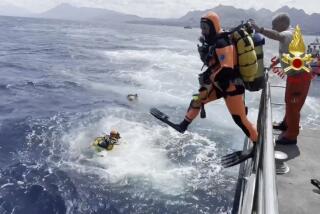Italian Archeologist Digs His Scuba Gear : Treasure: Government struggles to save rich underwater sites from plunderers.
- Share via
ROME — Many an underworld figure in Italy has ended up in a watery grave, so when Luigi Robusto, an off-duty police officer, spied a foot sticking out of the bottom of the Adriatic, he figured he had found the latest corpse.
Instead, Robusto, who dives as a hobby, made one of the most fabulous finds in the last few decades of Italian archeology--a bearded head, two arms and a left foot believed to be parts of 4th-Century BC Greek bronze statues.
Luckily for archeology, the diver was a member of the carabinieri , the paramilitary police corps that patrols Italy’s 5,000 miles of seacoast. It’s on alert for looters of ancient artifacts as well as drug smugglers and illegal immigrants.
The bronzes, discovered in 1992 off the coast of Brindisi, are under restoration for display in a museum.
But for countless other treasures of the deep, it’s finders keepers.
With high-tech expeditions plumbing the seas from Central America to the South Pacific for sunken treasure--quests for the Titanic and Spanish galleons are some recent examples--archeologists are racing against time to save sites from plunder.
Complicating their crusade is little recognition for underwater archeology as a discipline.
“Underwater archeology is still considered a side branch of archeological research,” complained one expert, Werner Johannowsky, writing in Italy’s first journal of undersea archeology, which made its debut this winter.
A few years ago, a cubbyhole of sorts was carved out by the Culture Ministry for an office for underwater archeology. Claudio Mocchegiani Carpano, an archeologist and diver who runs it, relies heavily on volunteers, the coast guard and carabinieri to protect and retrieve ancient treasures, most of which are found by chance.
That’s not all that much different from how things were in 1972, when a scuba diver off the coast of Calabria fished out Italy’s most celebrated undersea find, the stunningly handsome Riace Bronzes, a pair of life-size warriors, nearly half a ton apiece and possibly the work of the 5th-Century BC master Greek sculptor Phidias.
“In those days, we worked underwater on our own free time,” recalled Mocchegiani Carpano in his office near the Tiber, whose polluted waters he regularly searches for ancient Roman ships and cargo.
To get an idea of what straits underwater archeologists work in, imagine leaving the job of unearthing the equivalent of a Hadrian’s Villa, the popular tourist site on the outskirts of Rome, in the hands of amateurs.
That’s how the “excavation” off Capri of a sumptuous villa of 1st-Century Emperor Tiberius is being carried out.
Volunteers from Archeoclub, a nationwide group of archeology lovers, work every summer to reveal a little more of the baths, swimming pools and fish ponds that delighted the emperor and his entourage. Because the island off Naples is in an earthquake-prone area, the villa slowly sunk below sea level over the centuries.
“Capri was never (systematically) studied underwater,” said the leader of the project, Orlando Pandolfi, an engineer and Archeoclub official. “Before we came, there were looters and, only very sporadically, professional archeologists.”
When archeologists have to leave an underwater site, they sometimes cover it with cement or a metal grid.
Pandolfi hopes someday at Capri there will be glass-bottom boats for tourists and marked trails for divers.
“Italy has probably the most interesting seas in the world because for centuries all the trade routes passed by,” said Pandolfi. “There are thousands of shipwrecks and lots of submerged cities.”
Work underwater--by volunteers or by the state--moves slowly because of the cost.
It’s just like working on terra firma, “only you don’t excavate with a pick ax and it costs 10 times as much,” Mocchegiani Carpano said. With a minuscule budget, his dream of having staff archeologists, photographers and sketchers who know how to dive isn’t about to come true soon.
Digging out sunken wrecks has helped tell more about commerce, construction techniques and even what were the latest fads in household decorating--many Roman wrecks were filled with Greek antiquities to fill that empty niche or two in the atrium in some patrician house.
More to Read
Sign up for Essential California
The most important California stories and recommendations in your inbox every morning.
You may occasionally receive promotional content from the Los Angeles Times.













